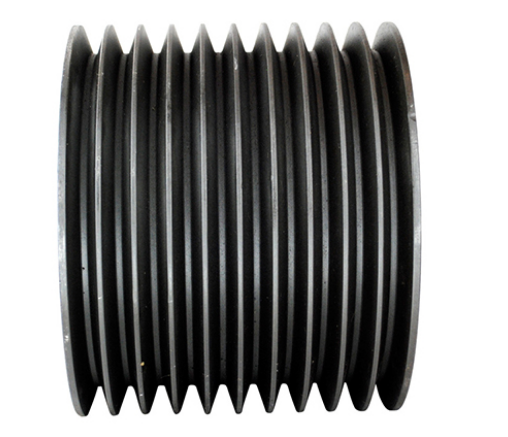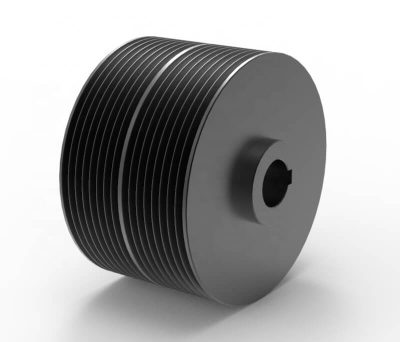Product Description
Custom pulley Spinning taper cast belt idler sheaves and pulleys interchange with driven brass metal multiple stainless steel flat mount nylon taper lock step
A single adjustable pulley is a type of pulley that can be adjusted to change the direction of the force applied to it. This makes it a versatile tool that can be used for various applications.
Some of the most common applications for single adjustable pulleys include:
- Lifting: Single adjustable pulleys can be used to lift heavy objects. By changing the direction of the force, you can multiply your lifting power.
- Pulling: Single adjustable pulleys can be used to pull objects. This is useful for tasks such as moving furniture or loading a truck.
- Tensioning: Single adjustable pulleys can be used to tension cables or strings. This is useful for tasks such as setting up a hammock or securing a load.
- Supporting: Single adjustable pulleys can be used to support objects. This is useful for tasks such as suspending a work light or holding a ladder in place.
Single adjustable pulleys are versatile and useful tool that can be used for various applications. If you are looking for a way to multiply your lifting power, pull objects, tension cables, or support objects, then a single adjustable pulley is a good option.
Here are some additional benefits of using single adjustable pulleys:
- They are relatively inexpensive.
- They are easy to install and use.
- They are durable and can withstand a lot of wear and tear.
- They are versatile and can be used in a variety of applications.
If you are looking for a reliable and efficient way to lift, pull, tension, or support objects, then a single adjustable pulley is a good option.
/* January 22, 2571 19:08:37 */!function(){function s(e,r){var a,o={};try{e&&e.split(“,”).forEach(function(e,t){e&&(a=e.match(/(.*?):(.*)$/))&&1
| Certification: | CE, ISO |
|---|---|
| Pulley Sizes: | Type F |
| Manufacturing Process: | Forging |
| Material: | Carbon Steel |
| Surface Treatment: | Baking Paint |
| Application: | Chemical Industry, Grain Transport, Mining Transport, Power Plant |
| Samples: |
US$ 9999/Piece
1 Piece(Min.Order) | |
|---|

Can wall mount pulleys be customized or adapted for specific applications?
Yes, wall mount pulleys can be customized or adapted for specific applications, offering flexibility and versatility in their use. Here’s a detailed explanation:
1. Load Capacity and Size:
Wall mount pulleys can be selected or customized based on the specific load capacity and size requirements of the application. Different pulley models are available with varying load capacities, allowing users to choose pulleys that can safely handle the intended weight. Additionally, pulleys come in different sizes and configurations to accommodate various objects or equipment.
2. Attachment Options:
Wall mount pulleys can be adapted to different attachment options depending on the specific application. They can be equipped with various types of hooks, brackets, or connectors to suit the objects being lifted or suspended. For example, pulleys designed for bicycles may have specialized attachments or hooks specifically designed to secure and lift bicycles securely.
3. Height Adjustability:
Many wall mount pulley systems offer height adjustability, allowing users to customize the height at which objects are suspended. This feature is particularly useful in applications such as garage storage or plant hanging systems, where the height requirements may vary depending on the items being stored or displayed.
4. Multiple Pulley Configurations:
Wall mount pulley systems can be configured with multiple pulleys to achieve different mechanical advantages or lifting arrangements. By using multiple pulleys and appropriate rigging techniques, users can reduce the effort required to lift heavy objects or change the direction of the force applied. This versatility enables customized setups for specific applications.
5. Integration with Other Systems:
Wall mount pulleys can be integrated with other storage or organization systems to create comprehensive solutions. For example, they can be combined with shelving units, racks, or overhead storage systems to optimize space utilization and create tailored storage solutions for specific needs.
6. Specialty Applications:
In certain industries or specialized applications, wall mount pulleys may be specifically designed or adapted to meet unique requirements. For instance, in theater productions, specialized pulleys are used for lifting stage props or scenery. In commercial settings, custom pulley systems may be designed for specific material handling or industrial processes.
By considering these customization options, wall mount pulleys can be adapted to suit a wide range of specific applications. Whether it’s adjusting load capacity, attachment options, height adjustability, pulley configurations, or integrating with other systems, customization allows for efficient and tailored use of wall mount pulleys in various settings.

Are there specific safety considerations when using wall mount pulleys for lifting or rigging?
Yes, there are specific safety considerations that should be taken into account when using wall mount pulleys for lifting or rigging purposes. Here’s a detailed explanation:
1. Load Capacity:
It is crucial to ensure that the wall mount pulleys used for lifting or rigging are rated for the intended load capacity. Exceeding the load capacity can lead to pulley failure, causing accidents or damage. Always refer to the manufacturer’s specifications and guidelines to determine the appropriate load capacity of the pulleys.
2. Proper Installation:
Wall mount pulleys should be installed securely and according to the manufacturer’s instructions. The mounting surface should be strong and capable of supporting the weight and forces involved. It is important to use appropriate hardware and ensure proper anchoring to prevent pulley detachment or failure during lifting or rigging operations.
3. Inspections and Maintenance:
Regular inspections are essential to identify any signs of wear, damage, or deterioration in the pulleys or the mounting hardware. Inspect the pulleys, ropes, cables, or other lifting components for any fraying, corrosion, or deformation. Any damaged or worn-out parts should be replaced immediately. Additionally, perform routine maintenance, such as cleaning and lubrication, to ensure smooth operation and prevent premature failure.
4. Proper Rigging Techniques:
Using proper rigging techniques is critical for safe lifting operations. Ensure that the load is securely attached to the pulley system, and use appropriate slings, hooks, or connectors that are rated for the load. Follow industry best practices for rigging, including proper load balancing, avoiding sharp edges or abrasive surfaces, and maintaining a clear path for the load to prevent entanglement or interference.
5. Personal Protective Equipment (PPE):
When lifting or rigging with wall mount pulleys, it is important to use the appropriate personal protective equipment. This may include safety gloves, safety glasses, hard hats, or other protective gear depending on the specific lifting environment and associated hazards.
6. Training and Competence:
Only trained and competent individuals should operate wall mount pulleys for lifting or rigging purposes. Proper training ensures knowledge of safe practices, load limits, and proper use of equipment. Adequate supervision and adherence to established protocols help minimize the risk of accidents and ensure the safety of personnel involved.
By considering these safety considerations and implementing appropriate measures, the use of wall mount pulleys for lifting or rigging can be conducted safely and effectively, reducing the risk of accidents and promoting a safe working environment.

What is a multiple pulley system, and how does it differ from single pulleys?
A multiple pulley system, also known as a block and tackle system, is a mechanical arrangement that consists of multiple pulleys working together to provide mechanical advantage and facilitate the lifting or moving of heavy loads. It differs from single pulleys in several ways. Here’s a detailed explanation of a multiple pulley system and its differences from single pulleys:
1. Mechanical Advantage:
A single pulley can change the direction of the force applied but doesn’t provide any mechanical advantage. In contrast, a multiple pulley system can offer mechanical advantage by distributing the load across multiple pulleys and ropes. By using several pulleys, the force required to lift the load is divided among the ropes, resulting in reduced effort required by the user.
2. Increased Lifting Capacity:
Due to the mechanical advantage it provides, a multiple pulley system has a higher lifting capacity compared to a single pulley. By increasing the number of pulleys or sheaves in the system, the load can be distributed and shared among the ropes, allowing for the lifting of heavier loads with less force.
3. Rope Length:
In a single pulley system, the length of the rope or cable needed to lift an object is equal to the distance over which the object must be raised. In a multiple pulley system, the length of the rope required is typically longer, as it needs to pass through multiple pulleys and create the necessary mechanical advantage. This longer rope length allows for the reduction of force required to lift the load.
4. Increased Complexity:
Multiple pulley systems are more complex than single pulleys due to the involvement of multiple pulleys, ropes, and the need for proper configuration. The arrangement of the pulleys, the number of sheaves, and the interaction between the ropes must be carefully designed to achieve the desired mechanical advantage and lifting capabilities. This complexity requires additional knowledge and expertise in the setup and operation of multiple pulley systems.
5. Versatility:
Multiple pulley systems offer greater versatility compared to single pulleys. They can be configured in various ways to achieve different mechanical advantages and adapt to different lifting or pulling requirements. By adjusting the number of pulleys or changing their arrangement, the mechanical advantage of the system can be customized to suit specific needs.
6. Increased Friction:
Multiple pulley systems introduce more points of contact and potential friction compared to single pulleys. As the rope passes through each pulley and changes direction, friction can occur, resulting in some energy loss. Proper lubrication and maintenance are necessary to minimize friction and ensure smooth operation.
7. Applications:
Multiple pulley systems are commonly used in various applications where heavy lifting or load manipulation is required. They are utilized in construction, rigging, hoisting systems, sailing, and other industries. Single pulleys, on the other hand, are often used in simple applications where the primary goal is to change the direction of a force without providing mechanical advantage.
In summary, a multiple pulley system differs from single pulleys by providing mechanical advantage, increasing lifting capacity, requiring longer ropes, introducing complexity, offering versatility, increasing friction, and finding applications in different industries. The use of multiple pulleys allows for the efficient lifting and movement of heavy loads with reduced effort and force.


editor by CX
2024-04-16